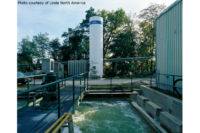Open to ozone
By Allison Bardic, Senior Editor
Ozone and UV technologies shed new light on pathogen intervention.
Meat and poultry industry use of ozone and ultra-violet (UV) light intervention technologies offers processors additional building blocks in their efforts to establish the ultimate food-safety approach.
Murray Hill, NJ-based BOC Gases, for example, integrates ozone and UV to control the four vectors of potential contamination in food plants: food and food contact surfaces, fluids such as injection marinades and brine/glycol chill fluids, and plant atmospheres.
"We have used our industry experience and food-processing knowledge to develop ozone and UV technologies designed for specific food-processing applications and aimed at controlling specific species," notes Mark DiMaggio, business manager, food safety markets, BOC. "These technologies are tailored to deliver just the right amount of ozone or UV light, depending on the application."
BOC has validated the efficacy of its technologies with third-party labs, and has submitted these certifications to USDA to win its acknowledgement that the technologies are effective, species-specific interventions that support Food Safety and Inspection Service rules.
"Earlier this year, the USDA acknowledged our ozone technology as being an effective Listeria intervention," adds DiMaggio. "We're currently undergoing the same review and validation process for our UV technology; we expect the acknowledgement to come within several months."
A number of processors have shown their support of ozone and UV light technologies. Phoenix, AZ-based Bar-S Foods early last year installed BOC's ozonated wash system and UV light pathogen intervention technologies in its three food-processing plants, while Canton, OH-based Fresh Mark recently installed two BOC ozone systems, including an on-site generator that produces ozone from ambient air, dissolves it in the plant's process water, and disperses it through a spray system directly onto unpeeled wieners and some food processing equipment.
Safe Foods Corporation, a North Little Rock, AR-based food-safety company, meanwhile, offers two UV technologies including the FreshLight® 200 series for brines and marinades, and the FreshLight® 600 series for conveyor belt disinfection. The FreshLight® 200 is placed within the brine/marination injection recirculation loop. The marinade, collected in the injector's reservoir, is disinfected before being injected again into product. The advanced ultraviolet light liquids disinfection technology is said to employ a natural, environmentally-safe, physical disinfection process, accomplishing disinfection rates of 99.9 percent on most fluids.
Safe Foods' FreshLight® 600 is a custom product, designed for a "clean room" environment and engineered for clean-room standards.
"Understanding the rising demand for enhanced products and recognizing the critical and unique needs regarding food safety in these applications, the meat industry is seeing the advantages of UV," says Mark Hill, chief marketing officer, Safe Foods. "FreshLight has already attracted the seal of approval from numerous leading food processors such as Maple Leaf Foods and Swift & Co.. As the enhanced product market share grows, so will the potential need of a low-cost, reliable technology that can offer an additional hurdle for food safety at a critical point within the process."
Zer-O-Loc
Q. What is your company's greatest food safety success story?
A. The development of the Zer-O-Loc hygienic envelope – a system of high-performance building products designed to withstand the continual harsh wash downs required in maintaining a sanitary environment.
Q. Define the latest food safety-related innovations to emerge from your company and their chief attributes and benefits for meat and poultry processors.
A. Factory Applied fiberglass-reinforced plastic (FRP): Factory-laminated FRP is an essential component of the Zer-O-Loc hygienic envelope. Fiber glass reinforced plastic is bonded to the surface of our panels during the manufacturing stage. Applying FRP at this stage is very important because it ensures the strongest bond between the FRP and the steel of the wall panel. While this procedure was originally an innovation developed to provide scratch and dent resistance, it was soon found to be an ideal product for high-wash down food areas. FRP can be applied a minimum of four feet up the wall, to the full height of the panel as well as the ceiling.
Walk-on Suspended Ceilings: The Zer-O-Loc walk-on suspended ceiling system allows maintenance of services above the ceiling while production continues below in a bright, sanitary and hygienic environment. Constructed with Zer-O-Loc EPS insulated panels, the finished Zer-O-Loc walk-on suspended ceiling system is energy efficient and durable and is ideally suited for low temperature, food processing, and controlled environment applications.
Woodless Doors: Zer-O-Loc manufactures a line of hinged and manual sliding cooler and freezer doors that contain no wood in the door leafs or frame components, making them ideal for food-processing facilities.
Stainless Steel: The finishing components (panels, doors, and trim) of the Zer-O-Loc hygienic envelope may be manufactured in Stainless Steel to avoid paint erosion and flaking, which can occur in high wash down areas.
Q. What type(s) of food safety solutions are meat and poultry processors most inquiring about?
A.When food processors contact Zer-O-Loc, their main concern is the durability of panels and doors. Will the system they choose allow them to meet strictly regulated sanitation requirements for the long term?
Q. What are the greatest food safety challenges facing meat and poultry processors today, and where do the most opportunities for improvement lay?
A. When it comes to panels and doors, meat and poultry processors depend on these products to maintain a sanitary environment. Within these environments, panels and doors are subjected to continual, harsh wash downs, and can potentially break down (paint erosion or flaking), resulting in potential food contamination.
Food processors using the Zer-O-Loc system notice a tremendous improvement in performance and durability within their plant environments.
Q. What food safety issues have most impacted your business over the past year and what can the industry expect from your company during the next 12-24 months?
A. Plant sanitation is the primary issue to our food processor customers. This has always been a major concern for that sector of our customer base, which prompted the development of the Zer-O-Loc Hygienic Envelope.
During the next 12-24 months and beyond, we will strive for continuous improvement. We are always looking at product innovations to help our customers be more successful in their operations.




